-

Towards the end of last year Cavaliero Finn HQ was sent the most beautiful catalogue of colourful sculptures by Mimi Joung. They were quite unlike anything we’d ever seen and we loved them; their bright colours and playfulness made us feel happy. We followed Mimi on instagram and became further enchanted with each image on her feed so much so that we promptly paid a visit to her studio in South London to see the work in the flesh.
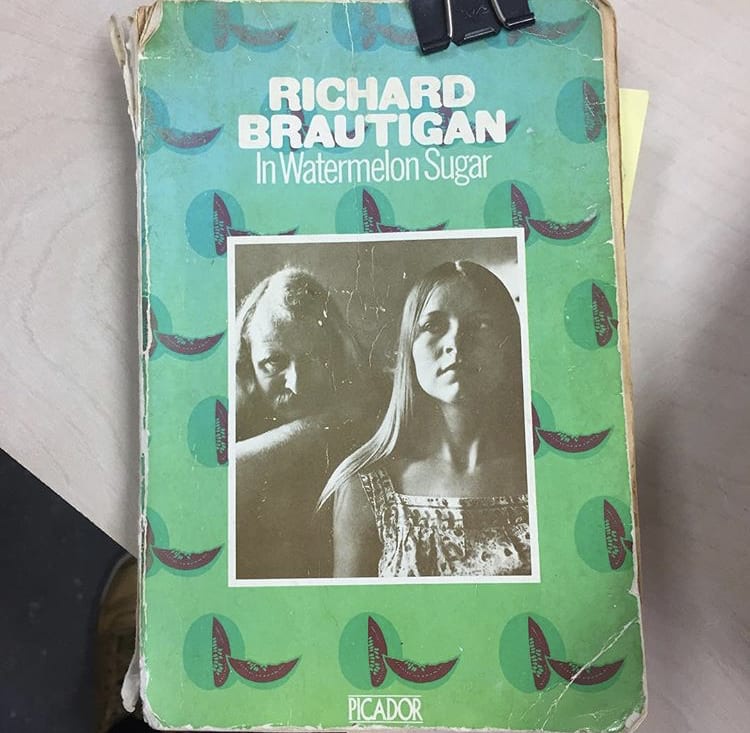
This well thumbed book, ‘In Watermelon Sugar’ by Richard Brautigan published in 1968 provides the inspiration for an ongoing body of work by Mimi. Set in the aftermath of a fallen civilisation it focuses on a commune in a utopian place iDEATH where every day has a different coloured sun and the people lead gentle lives in Watermelon Sugar. Mimi’s work explores language and every ceramic sculpture she produces encompasses the words from each chapter, starting and ending where each chapter starts and stops. Like poetry each chapter carries its own uniqueness made up of strange and dreamlike quotes which are incorporated into her pieces sometimes recognisable at other times more abstract in form.
We are really pleased to be presenting work by Mimi at our A Sense of the Familiar show. The pieces we’ve selected detail chapters from the book which explore nostalgia and memories. We asked Mimi a few questions in the run up to this show to give you an insight into her work and to share our enthusiasm of it.
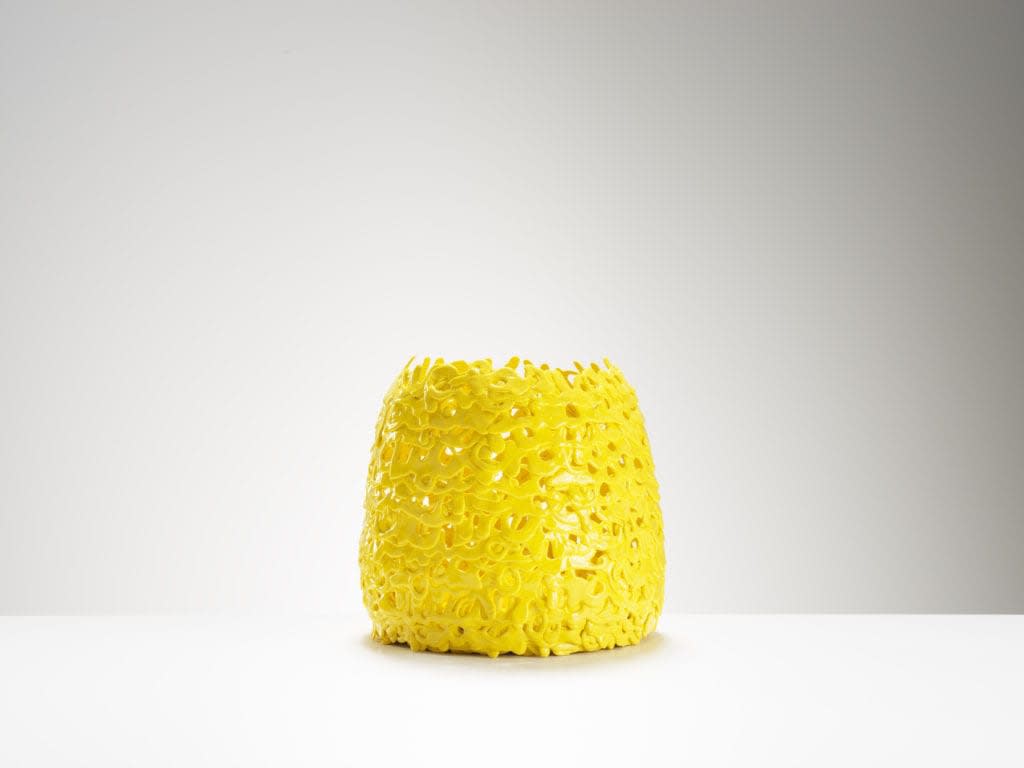
Tigers Again, Yellow Porcelain Slip, 25 w x 25 h cm, 2018
CF: What was it about Richard Brautigan’s novel ‘In Watermelon Sugar’ that inspired you to create these works?
MJ: I am a very inquisitive reader and have always liked books that have an imaginative world that is far away from reality. My partner was working on an exhibition based around a poem by Richard Brautigan and we’d been discussing his approach to language and imagination. I loved the title and the 70s cover image of ‘In Watermelon Sugar’ and, when I started to read, it felt like each chapter was a self-contained poem that wanted to be turned into a piece of art.
The Tigers Again chapter sees characters Charley and Pauline talk about their past memories of the tigers, reminiscing about the times before they were all killed off and brought to IDEATH? How do your memories of your upbringing in Korea infiltrate your work do you think?
My memories of Korea are all about my family, my parents working in their rice cake factory, daydreaming as my sisters and brother grew up around me. These memories fade when you are far away in space and time and the words that we use to communicate with each other become tangled and misunderstood. Memories of home are quite nostalgic but are never the same as we imagine. When I read about the tigers, I felt something similar. All that is left of the tigers are stories … but what is true and what is make believe?
Tigers Again, Yellow Porcelain Slip, 25 w x 25 h cm, 2018
CF: Can you tell us bit about the link between the written word and your sculptures?
MJ: Many of my works use the written word as the starting point for new ceramic forms. A letter to my mother (2006-15) acted as a bridge between my life in London and my life as a child in Korea; Waiting (2010-2015) related to a lover’s discourse (Roland Barthes) and the tension between the lover and the loved one. This body of work is more abstract. I am making in order to discover; each leaky vessel is made of words but the words are obscured and the meaning flows away like water from a broken pot.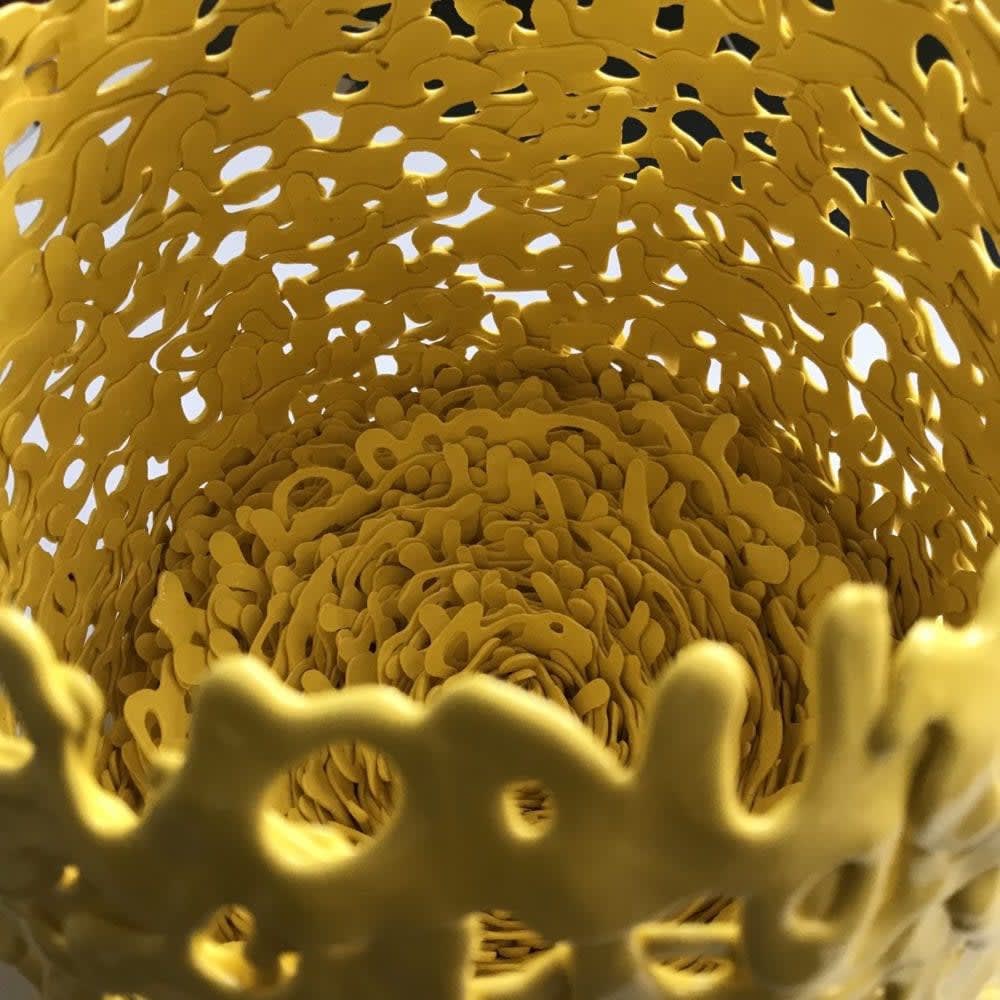
Tigers Again detail
CF: How much planning goes into each piece? It’s amazing how the chapter opens and closes making a complete whole, is this controlled?
MJ: I think about the scale and shape of the work when I read each chapter but the exact dimensions come about through the act of making. I can not stop until the work is finished so everything is controlled by the process of writing, drying, taping and building.CF: What role does colour play in your work?
MJ: I have always been interested in the colour and form of work; how it is produced and how it makes me feel. In this work, colour creates connections and disconnections..sometimes it relates specifically to the words in the chapter and at other times it relates to a feeling in the words or my own mood! Some chapters are very very sad, but I will use bright colours; other chapters are bright but have a dark heart…mute colours may feel right. Overall, I am trying to create a landscape from the work; a landscape like the strange world that is, ‘In Watermelon Sugar’.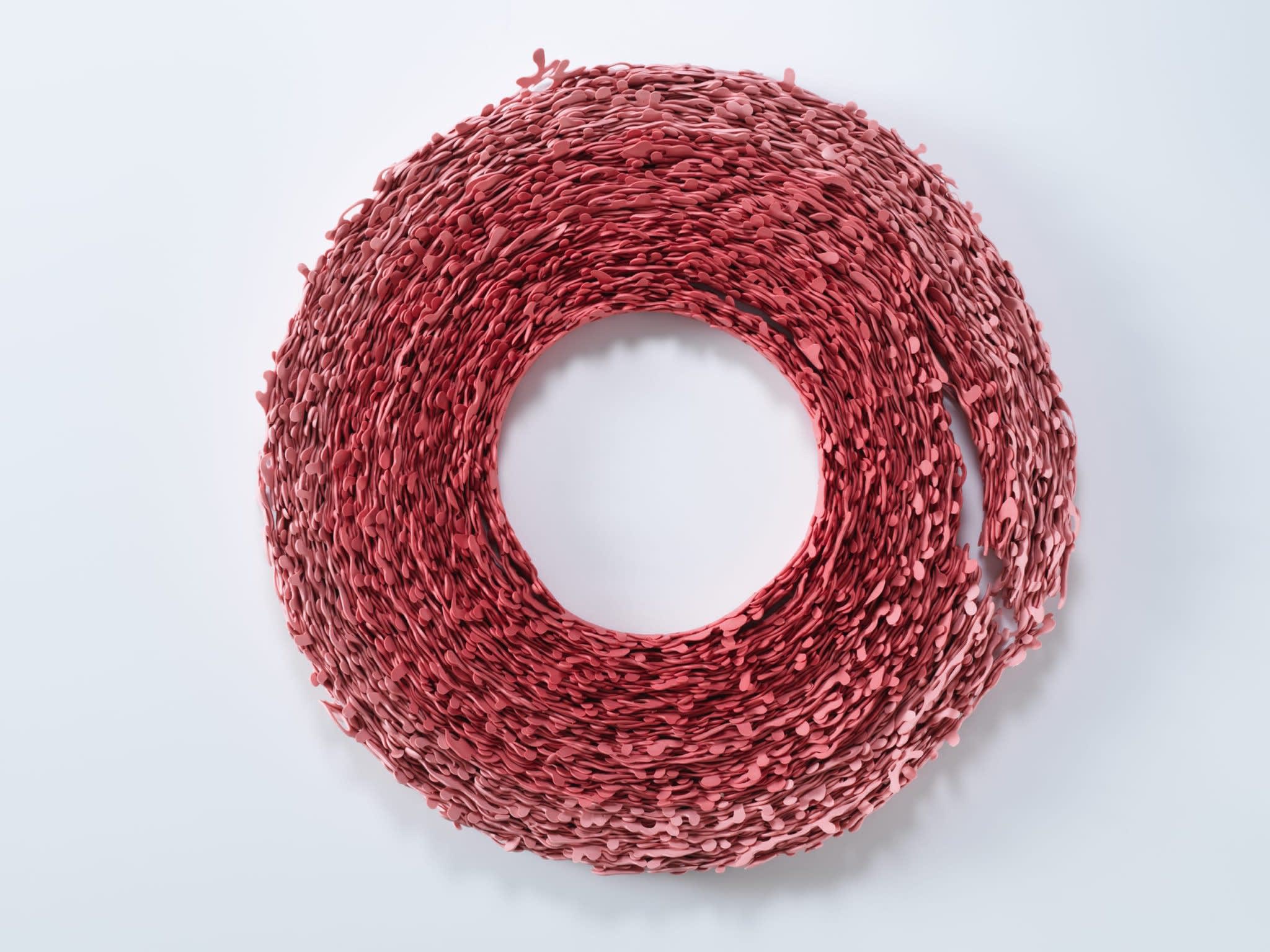
Arthmetic, casting slip, 2018/19
CF: Walk us through making one of your vessels… what materials and techniques do you use?
MJ: For this body of work, I am using porcelain casting slip which I colour using ceramic high temperature body stain. Before I start a piece, I read the chapter and think about its size, its form and its colour. I then write the words of the chapter using a small ‘ American Mustard bottle’ which allows me to work with accuracy and speed. I write onto a large plaster bed which absorbs the moisture from the slip clay while allowing me to remove the words in tact once they are semi-dry. I then build up the vessel by taping the words together like a coil pot. I fire at high temperature and sometimes design the pieces so that they slump and move during the firing to create new shapes.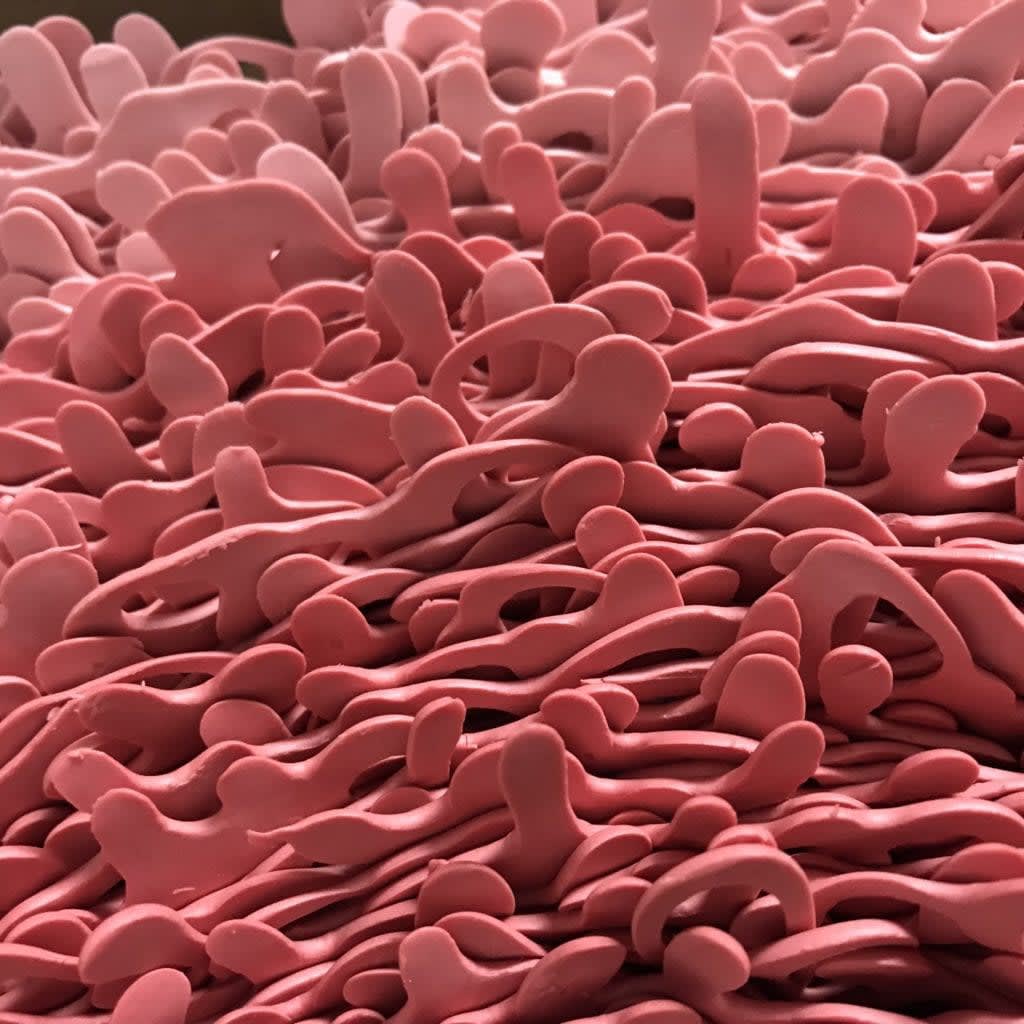
Arthmetic, casting slip, 2018/19 (detail)
CF: How did you become a ceramicist?
MJ: Since I was young I always knew that I wanted to be a creative person. I won a scholarship to go to Art School in Korea and during the first year I enjoyed throwing and working with clay. Ever since then I always go back to clay even though I also work with other materials – glass, found objects, wool and even jigsaws! Clay suits my personality. It requires persistence, patience, acceptance of failure and the pleasure of discovery through making.
Half chapter of The Watermelon Sun, Black Porcelain Slip, 18 w x 9h cm
CF: What makes your work unique?
MJ: I make my work unique! It is technically challenging, requiring a good understanding of the material and the process. Its also very original, both from a philosophical perspective and through its form.CF: Which artists particularly inspire you and why?
MJ: I am inspired by female artists who consistently push boundaries; Lucie Rie, Jennifer Lee, Ruth Duckworth, Anna Maria Maiolino, Eva Hesse, Louise Bourgeois, Agnes Martin, Fiona Banner, Cornelia Parker, Sophie Calle, Annette Messager, Doris Salcedo…. I am grateful to them because they opened the door for us and showed us what is possible.
Work by Loewe Craft Prize Winner 2018, Jennifer Lee
CF: What’s next for you?
MJ: In Autumn, a small selection of my sculptures are showing in a large group exhibition at the Gallery Metzler in Germany. At the moment I am focussing on completing ‘my In Watermelon Sugar’ project. There are over 80 chapters and I am only half way through – after more than 18 months! So I have plenty to do without thinking about next steps. Each piece is a discovery in itself and I am constantly learning what is possible and how each form makes me feel.
Cavaliero Finn is showing a small selection of Mimi’s work at A Sense of the Familiar which is open on May 11/12 and 18/19 May at the home gallery.See Mimi's Work here